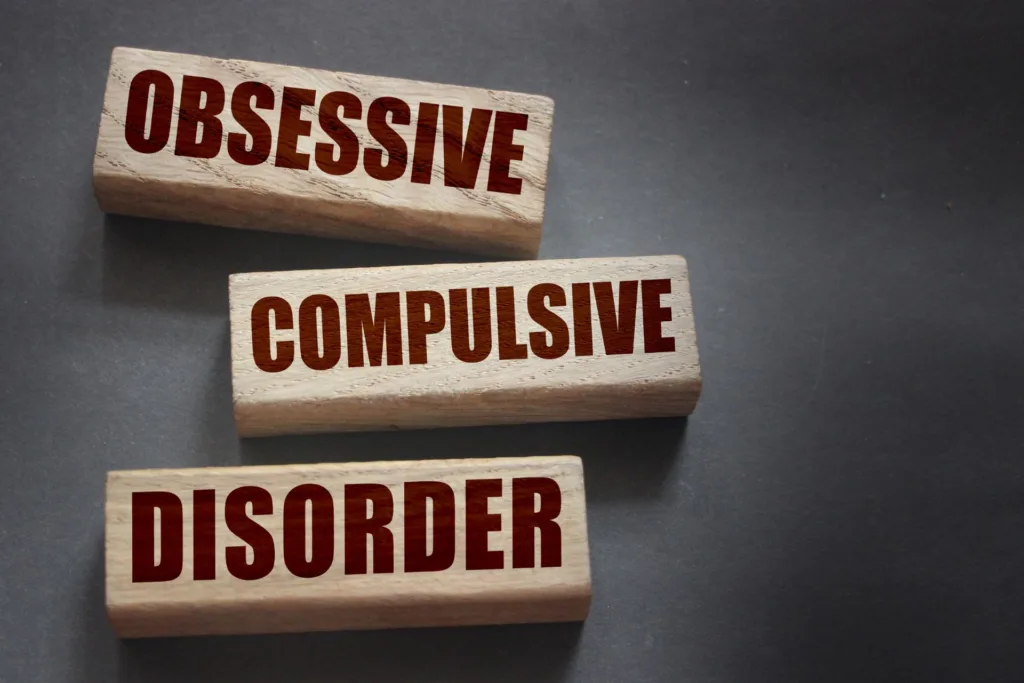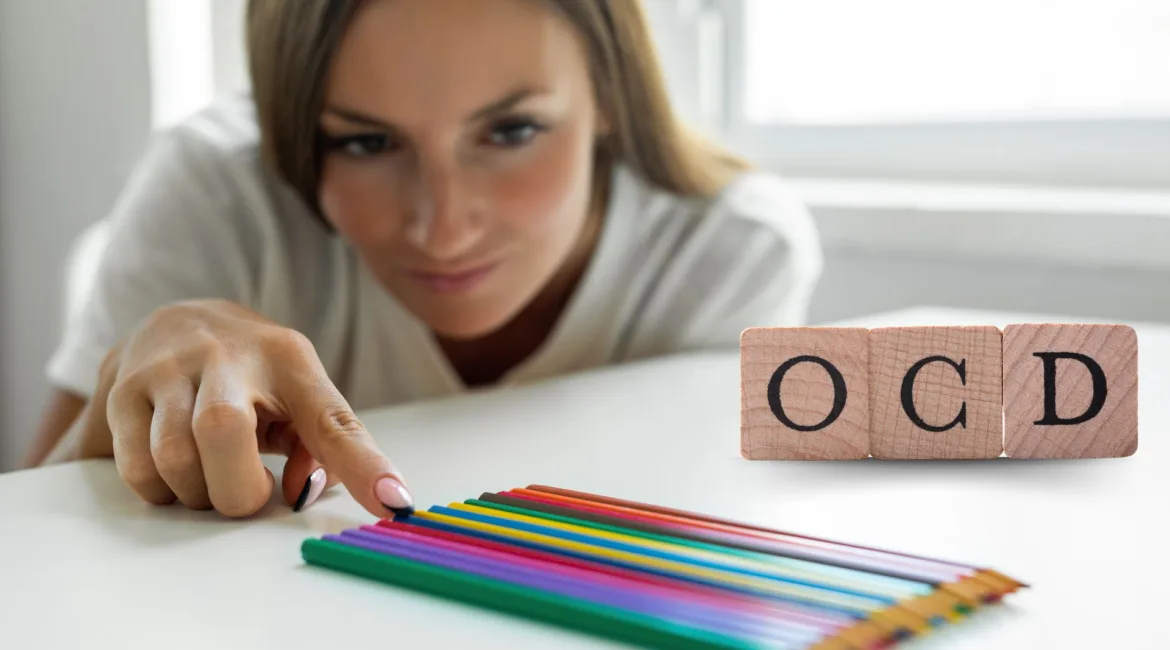Obsessive-compulsive disorder (OCD) affects millions worldwide, impacting an estimated 2-3% of people. It can feel like thoughts and behaviors are tangled in a tight knot, with underlying intrusive thoughts and compulsive behaviors being the common thread, even though the specific themes and rituals vary.
It’s not a character flaw, a sign of weakness, or something you brought upon yourself.
It’s a real mental health condition, and like any other illness, it deserves understanding, compassion, and most importantly, effective treatment.
What is OCD?
Essentially, OCD occurs when a person experiences intrusive and disturbing thoughts, images, or impulses that trigger intensely distressing feelings of anxiety.
To cope with these scary obsessions, the person starts doing repetitive behaviors or mental routines known as compulsions.
These compulsive actions provide temporary relief from anxiety but end up feeding into a dysfunctional cycle.
With OCD, there is frequently a disconnect between a person’s rational thoughts and their actual fears.
A person with the disorder often knows that their obsessions are senseless or unrealistic but can’t control their anxiety or compulsive behaviors.
Unraveling the Knot of Obsessions: A Psychologist's Guide to Understanding OCD
As a clinical psychologist, I’ve witnessed firsthand the disabling impact of OCD. It can chip away at your daily life, turning simple tasks into monumental hurdles and draining your emotional energy.
You might get stuck checking the stove a dozen times, washing your hands until they crack and bleed, or arranging objects in a certain order, only to feel the same awful anxiety moments later.
Intrusive thoughts, worries, and anxieties fill your mind, making you do repetitive actions in a desperate attempt to quiet the mental storm.
But like a knot pulled too tight, the more you tug at your compulsions, the more constricted you become.
However, it often goes unrecognized and undiagnosed because of the shame and stigma that still surrounds mental illness.
The Two Sides of the Coin: Obsessions and Compulsions
Let’s break down the two sides of the OCD coin: obsessions and compulsions.
Obsessions are those unwanted, persistent thoughts, images, or urges that feel intrusive and distressing.
They can be about fears of germs or harming yourself or others, perfectionism or inappropriate sexual thoughts.
The common thread is that these thoughts are unwanted, often illogical and cause significant anxiety.
Compulsions, on the other hand, are the repetitive behaviors or mental acts you perform in response to your obsessions.
They’re driven by a mistaken attempt to reduce anxiety or prevent feared consequences.
This could involve excessive handwashing, repeated checking, precisely arranging items, or mental rituals like counting or chanting.
Demystifying the Maze: Exploring Subtypes and Related Disorders in OCD
Obsessive-compulsive disorder (OCD) isn’t a monolith. It’s a kaleidoscope of anxieties and compulsions that show up in diverse ways, weaving through different themes and connecting with other mental health conditions.
Understanding these nuances is crucial for navigating the complexities of OCD and finding the most effective treatment path.
Exploring the Subtypes:
Imagine OCD as a sprawling forest, each path leading to a distinct subtype. Here are some of the most common:
Pure O OCD: This subtype has intrusive thoughts without visible compulsions. The anxieties are often focused on harm, morality, or philosophical ruminations, leaving individuals trapped in a mental labyrinth.
Contamination OCD: Fears of germs and dirt lead to excessive handwashing, cleaning rituals, and avoiding certain objects or situations.
Checking OCD: Repeatedly checking things like locks, appliances or work for mistakes fuels this subtype, caused by a fear of errors or consequences.
Symmetry/Ordering OCD: A need for order and precision defines this subtype, seen in meticulously arranged items, color coding, and strict routines.
Additionally, there is symmetry/ordering OCD, hoarding OCD, religious/scrupulosity OCD, and more. Individuals often experience a blend of subtypes, therefore, the key is to identify the specific themes and triggers that fuel your OCD as this will guide your treatment approach.
Common Obsessions and Compulsions
The compulsive behaviors of OCD usually relate directly to the type of obsessions the person is experiencing. Some examples include:
- Excessive hand washing or showering
- Skin-picking and hair-pulling
- Hoarding useless items
- Checking door locks, appliances, work tasks for mistakes
- Excessive counting, repeating words or tapping
- Arranging items symmetrically
- Praying excessively or repeating mantras
As you can see, OCD compulsions vary greatly but temporarily relieve the fear and anxiety caused by the obsessions, perpetuating a difficult cycle.
This results in a self-perpetuating cycle that becomes difficult to break.
Causes and Contributing Factors
Researchers do not know the exact causes of OCD but biological and environmental factors likely both play a role.
There seems to be some genetic component, as OCD tends to run in families.
Brain scans of people with OCD also differ in the frontal cortex and deep brain areas compared to people without the disorder.
There also seems to be a link between OCD and the brain’s ability to process and circulate serotonin, a chemical that controls mood, anxiety, pleasure, and other functions.
People with OCD often have low serotonin levels, and medications that increase serotonin like SSRIs can be an effective treatment (more below!).
Environmental experiences, especially during childhood, also impact the development of OCD. Links have been established between childhood trauma or abuse and later struggles with the disorder. Other environmental factors may increase someone’s risk as well.
Overall, it seems that people are born with a genetic tendency for OCD behaviors. Then some combination of biological changes and life experiences triggers the onset of symptoms.
More research is still needed to clarify these causal relationships.
Signs and Symptoms
Wondering if you or a loved one may have OCD? Consider whether you relate to any signs such as:
- Spending over 1 hour per day engaged in obsessive thoughts, repeated actions, or mental compulsions
- Unable to shift focus away from distressing and fearful obsessions
- Experiencing rigid and strict rituals around routine activities like getting ready, cleaning, leaving the house
Additionally, strong feelings of embarrassment, recurrent intrusive thoughts, sensory issues, an awareness that obsessions seem unrealistic but inability to rationale through the fear all potentially point to OCD.
The disorder and its related behaviors cause significant life impairment for most people battling it. Symptoms typically become progressively worse without treatment.

The Vicious Cycle: How OCD Feeds Itself
Here’s where the knot metaphor truly shines. The more you engage in compulsions, the more power you give to the obsessions, like feeding a fire with anxiety.
The temporary relief you feel after completing a compulsion is fleeting, and the obsessive thoughts soon return, often with greater intensity.
This cycle can become a relentless loop, trapping you in a prison of your own anxieties. However, there are ways to break free.
Breaking Free from the Knot: Effective Treatment Options
Recognizing your specific struggles allows therapists to tailor interventions to address your unique needs. Here are some tools in the toolbox:
- Cognitive Behavioral Therapy (CBT), specifically Exposure and Response Prevention (ERP), is the gold standard for treating OCD.
- Medication: Antidepressants can help manage anxiety and OCD symptoms, especially combined with CBT.
- Mindfulness and Relaxation Techniques: Learning to manage thoughts and feelings through mindfulness and relaxation techniques can help cope with OCD-related distress.
Recovery is a journey, but with proper support and tailored treatment, you can navigate OCD, unravel knotted anxieties, and reclaim your life.
Navigating the Neighborhood: Related Disorders
OCD doesn’t live in isolation. It often coexists with other mental health conditions, creating a complex web of symptoms.
Finally, several other disorders exist within the OCD spectrum of illnesses. People often receive multiple diagnoses across these interconnected conditions
- Anxiety Disorders:Generalized anxiety, social anxiety, and panic disorders can intertwine with OCD, increasing distress and making it hard to separate intrusive thoughts from real worries.
- Depression: The emotional toll of OCD can lead to depression, characterized by low mood, loss of interest, and fatigue. Untreated depression can worsen OCD symptoms, creating a vicious cycle.
- Body Dysmorphic Disorder (BDD): Being preoccupied with perceived appearance flaws can overlap with OCD checking and reassurance seeking, complicating diagnosis and treatment.
- Eating Disorders: Anorexia nervosa, bulimia nervosa, and eating disorder can share compulsive elements with OCD, particularly around food and body image.
Excoriation disorder: Uncontrollably picking at scabs, acne or small skin flaws for hours, causing tissue damage and visible skin lesions, often focused on the face, arms and hands.
Hoarding disorder: Unable to discard excessive, seemingly useless items like old newspapers, receipts or worn clothing, resulting in cluttered living spaces.
Trichotillomania: Unable to resist urges to pull out scalp hair, eyebrows, etc., sometimes causing visible bald spots, bringing temporary relief but significant distress. Doing so brings temporary relief but inevitably causes significant distress.
Accurately identifying broader OCD, a specific subtype, or a related condition allows customized treatment plans.
There are shared compulsions but also key nuances across these disorders that inform intervention approaches.
Understanding co-occurring conditions is vital for holistic treatment addressing all aspects of your experience.
Taking the First Step: Making an Appointment with Dr. Benejam
If you’re ready to break free from OCD, I encourage you to contact me.
As a clinical psychologist specializing in anxiety, I can provide evaluation, diagnosis, and treatment tailored to your needs.
Together, we’ll develop a plan to help you manage symptoms, regain control, and live fulfilling.
Make an Appointment with Dr. Benejam If any part of this article resonates and you’re ready to seek answers, schedule a consultation with a respected OCD specialist.
Call (561) 376-9699 / (305) 981-6434 or complete this brief form and a member of our office will contact you promptly to book a session.
During our appointment, we’ll thoroughly assess your symptoms, discuss proven treatment plans, and help you start feeling hopeful again.
Don’t let OCD dictate your story. Take the first step towards unraveling the knot and reclaiming your peace of mind.





